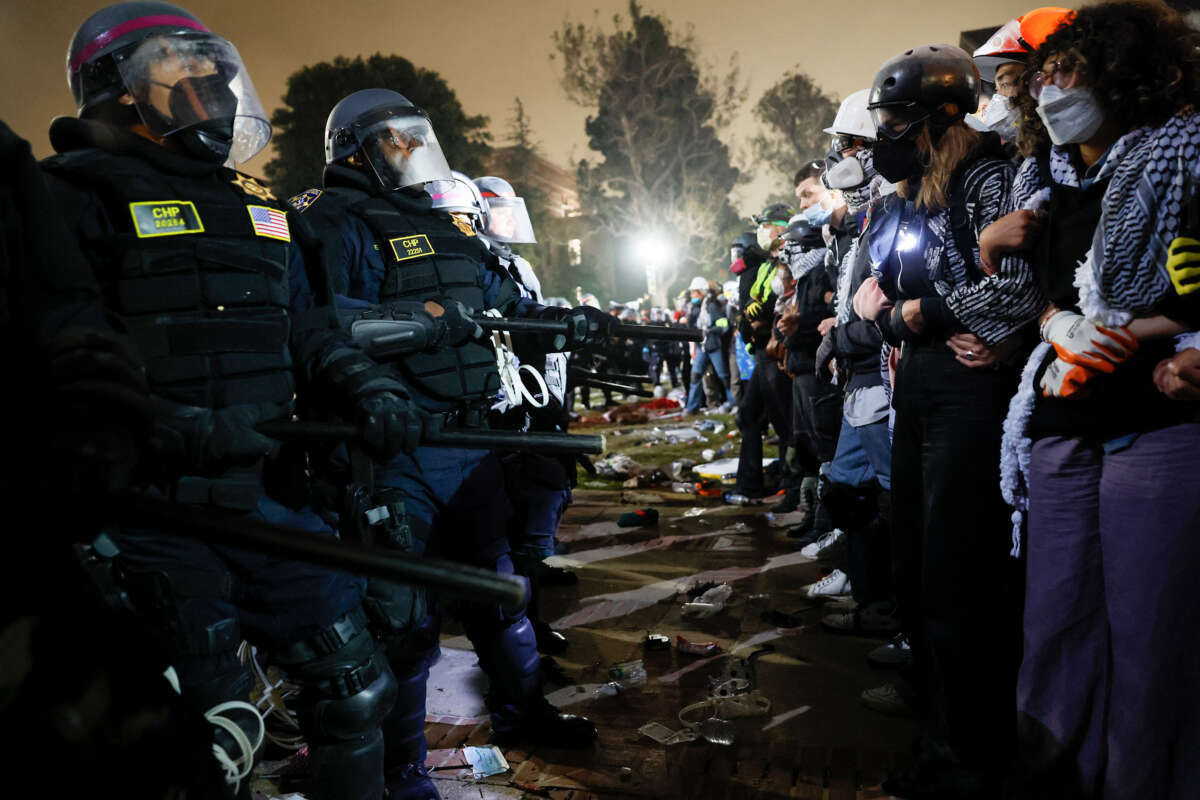Part of the Series
Struggle and Solidarity: Writing Toward Palestinian Liberation
April 30, 2024, was the 56th anniversary of Columbia University calling in the police to arrest 700 students who had taken over Hamilton Hall in a protest against racism and the war on Vietnam. It was also the day when the Columbia administration invited the NYPD onto its campus for the second time in less than two weeks. Police in riot gear proceeded to arrest pro-Palestinian students, including those occupying Hamilton Hall, which the students had renamed Hind Hall in honor of a 6-year-old Palestinian girl killed by the Israeli military. Sadly, Columbia University is not alone in calling in police and state troopers to shut down the overwhelmingly peaceful Gaza encampments that have been spreading on campuses across the country. These latest escalations come on the heels of months of crackdowns on students protesting against Israel’s war on Gaza across the nation.
As a professor of education at Barnard College, Columbia University, I have been deeply troubled with the ways that colleges and universities are handling student protests, and I am particularly struck by the complete abandonment of a mission to educate. At Barnard College and Columbia University, the administrations have used an ever-changing set of administrative rules to punish pro-Palestinian student protesters, escalating from treating our students as disobedient children who keep breaking the rules to arresting them as criminals. What if, instead, we recognized student protesters as educators, fully engaged teachers and learners in our community?
Student protesters are serving as educators in three critical ways.
Student Protesters Are Educating Through Their Questions
Students are asking big and uncomfortable questions that take history into account and challenge the hegemonic narratives on offer. Protesting the unfolding genocide in Gaza, they refuse to begin the story on October 7, asking instead that we understand the conflict in relation to the history of Nakba, occupation, apartheid and siege. These historical questions lead to others about the roles and responsibilities that we in the United States (and by extension, our institutions of higher education) have to take for justice in Palestine.
At my institution, the student group organizing the Gaza encampment Columbia University Apartheid Divest (CUAD), has made five demands on the university, all of which raise critical questions. To take one example, the first demand — divestment from “companies and institutions that profit from Israeli apartheid, genocide, and occupation in Palestine” — requires us to engage in important and serious ethical conversation: What does it mean for our institutions of higher learning (and by extension, ourselves) to profit off of harm? In what I find a particularly telling move, this demand has broadened as it reverberated through Palestine solidarity encampments across the country, echoing back an even bigger question about whether our institutions should profit off of any investments in military machinery or companies that trample on human rights. Other CUAD demands led to more questions: For example, “stop the displacements” could lead us to inquire into the similarities and differences between the “land grabs” in “Harlem, Lenapehoking, and Palestine.” Students are educating themselves and others through inquiry and curiosity that lead to other questions and connections, uncovering patterns and structures of power.
Student Protesters Are Educating Through Their Actions
Since the beginning of Israel’s war on Gaza, student protesters have been building a transnational solidarity movement demanding justice in and for Palestine. By insisting that understanding be tied to action, they are modeling democratic political practice at its best. They are forming study groups, educating themselves about antiwar protests of the past and building on what they have learned to inform the current moment. Through democratic decision-making and collective action, they are forging multiple perspectives into coherent action. As made clear by the wave of Gaza encampments that have spread far and wide on U.S. campuses in the past two weeks, students are educating each other about how to mount peaceful protests around a coherent set of actions for justice in Palestine.
By insisting that understanding be tied to action, they are modeling democratic political practice at its best.
Student Protesters Are Educating Through Community Building
Against the backdrop of mainstream media and politics that are using charges of antisemitism to create and maintain the fiction that this is a binary, religious conflict, student protesters have built a community of multiple and sometimes divergent perspectives and practices. The Gaza solidarity encampments are sites of protest and joy, places where folks are coming together to learn, sing, dance and break bread. Muslim prayers and Jewish seders build community across faith and practices. South Asian dance troupes perform next to Palestinian dabkeh dancers. Students are teaching each other about their lives and communities. They are drawing up collective agreements for community conduct and educating each other about how to embrace peaceful action even in the face of provocation. Teach-ins join faculty and students together in learning communities. Student protesters in the encampments today are a picture of the best any education can offer — a community in which all are both teachers and learners, and curiosity and large questions drive intellectual inquiry.
I was in college in 1982 when an already devastating Israeli invasion of Lebanon culminated with the massacre of approximately 2,000 Palestinian civilians in the Sabra and Shatila refugee camps. Three of us staged a protest on campus. We asked a lot of questions then. I was never sure if anyone heard us. Today, the scale and energy of student protest suggests that perhaps those whispers in the fall of 1982 (on my campus and others) were the start of an education that has become a tidal wave today.
